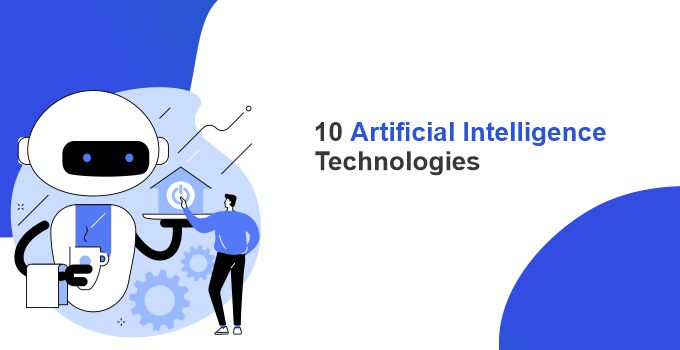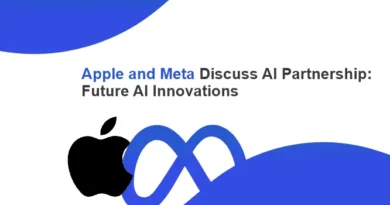Best 10 Artificial Intelligence Technologies in 2024
- Emerging Artificial Intelligence Technologies
- Top 10 Artificial Intelligence Technologies
- 1.Natural Language Generation (NLP)
- 2. Speech Recognition
- 3.Virtual Agents
- 4.Decision Management
- 5.Biometrics
- 6.Machine Learning
- 7.Robotic Process Automation
- 8.Peer-to-peer Network
- 9.Deep Learning Platforms
- 10.AI-optimized Hardware
- Artificial Intelligence Technologies Application and Challenges
Artificial Intelligence (AI) is like teaching computers to think and act like humans. It started getting a lot of attention about twenty years ago, even though the idea has been around for over fifty years. AI allows computers to do things like understanding human language, recognizing voices, making decisions, and controlling robots. It’s been growing really fast and is now a part of so many things we use every day. By learning about AI and how it works, we can keep up with the latest tech trends.
Emerging Artificial Intelligence Technologies
Artificial Intelligence (AI) has revolutionized our world, impacting every industry and part of society. The idea of AI, creating machines that can think and act like humans, was first introduced in 1956. For a long time, AI was a unique field on its own, but with the rise of the internet, it has grown rapidly.
Now, AI is everywhere, from how we work to how we live our daily lives. Known as AI, this technology mimics human intelligence in machines, making them smarter and more capable in various tasks. Here are some examples:
- Smartphones: Your smartphone is a treasure trove of AI. Features like voice assistants (think Siri and Google Assistant), facial recognition to unlock your device, and even the camera technology that optimizes your photos are all powered by AI.
- Social Media: Ever wonder how social media platforms know what to show you? AI algorithms analyze your behavior to personalize your feed, suggest friends, and even identify and filter out inappropriate content.
- Online Shopping: AI makes shopping online a breeze. It recommends products based on your browsing and purchase history, helps with customer service through chatbots, and optimizes logistics for faster delivery.
- Streaming Services: Netflix, Spotify, and other streaming platforms use AI to analyze your preferences and watch history to recommend movies, shows, and music you might like.
- Smart Home Devices: Devices like smart thermostats, lights, and security cameras learn from your habits to improve energy efficiency, provide convenience, and enhance home security.
- Navigation and Travel: Apps like Google Maps use AI to analyze traffic in real-time, suggest the fastest routes, and even predict future traffic conditions.
- Email: Ever noticed how your email app filters out spam or categorizes emails into primary, social, and promotion tabs? That’s AI working to organize your inbox without any effort from you.
- Banking and Finance: From fraud detection systems that monitor unusual transactions to chatbots that help with your banking queries, AI is making banking safer and more accessible.
- Healthcare: AI technologies are used for diagnostic purposes, such as analyzing images to detect diseases, and personal health monitoring through wearable devices.
- Education: Personalized learning platforms use AI to adapt to each student’s learning pace and style, providing customized resources and assignments.
Top 10 Artificial Intelligence Technologies
Many cutting-edge technologies are part of artificial intelligence today. From small startups to huge companies, everyone is competing to use AI to improve how they work, analyze data, and more. We’re going to look at ten of the newest artificial intelligence technologies that are making a big splash in the world right now.
You must be looking for artificial intelligence technologies examples, as this is the era of AI. So here we have compiled a artificial intelligence technologies list for you that you can learn and utilize for you work:
1.Natural Language Generation (NLP)
Machines work and talk in a way that’s different from how our brains do. Natural language generation is a cool tech that changes structured data into everyday language. Machines are set up with text analytics and NLP artificial intelligence technologies to change the data into a format that people can easily understand.
Natural language is a part of artificial intelligence that helps people who create content to make their work automatic and get it out in the way they want. Content makers can use this automatic content to share on different social media and other platforms to reach the people they want to talk to. With this, there’s less need for people to step in because the data will be changed into the formats they want. This data can also be shown in pictures like charts and graphs.
2. Speech Recognition
Speech recognition is another key part of artificial intelligence that turns what we say into something computers can understand and use. It’s like a link that helps people and computers talk to each other. This technology can understand and change spoken words in many languages into computer languages. Siri on the iPhone is a great example of how speech recognition works.
3.Virtual Agents
Virtual agents are now important tools for people who create educational materials. A virtual agent is a program on a computer that talks to people. Websites and mobile apps use chatbots as their customer service helpers to talk to people and answer their questions. Google Assistant can organize your meetings, and Amazon’s Alexa makes shopping simpler.
A virtual assistant can also work as a language helper, understanding your likes and choices. IBM Watson gets what people usually ask in customer service, even when the questions are asked in different ways. Virtual agents are also provided as a service through software.
Recommended for You: How to Start an LLC (Limited Liability Company)
4.Decision Management
Decision management is a strategic approach that uses automated systems to process and analyze data to make decisions. These systems leverage rules, algorithms, and predictive analytics to evaluate information and deliver recommendations or make decisions automatically.
This approach is widely used in business to optimize operations, manage risks, and personalize customer interactions. By automating routine decision-making processes, organizations can respond more quickly to changes, reduce human error, and focus human resources on more complex tasks.
Decision management tools integrate with various data sources and applications, enabling businesses to implement consistent decision-making processes across different areas, from customer service to financial planning.
5.Biometrics
Deep learning is a subset of artificial intelligence that mimics the way humans learn, using structures called artificial neural networks. The “deep” in deep learning refers to the numerous layers within these networks. While a basic neural network might have just a few layers, deep learning networks can have up to 150 hidden layers, allowing them to process complex data more effectively.
This method is particularly powerful when dealing with large amounts of data and requires advanced computing power, such as graphics processing units, to function efficiently. Deep learning algorithms organize themselves in a way that they can make predictions automatically, learning from examples.
This technology is being applied in various fields, including aerospace and military for object detection from space, workplace safety by spotting potential hazards to workers near machinery, and healthcare for identifying cancer cells, showcasing its wide-ranging impact and utility.
6.Machine Learning
Machine learning is a part of artificial intelligence that lets machines understand data without needing to be directly programmed. It uses special methods to help companies make smart choices by looking at data with algorithms and statistical models. Businesses are putting a lot of money into machine learning because it’s very useful in many different areas.
In healthcare, machine learning is used to go through patient data to guess illnesses and figure out the best treatments. Banks and financial companies use it to look at customer data to recommend investments and to spot and stop fraud. Retail companies use machine learning to predict what customers will want next and understand shopper behavior by studying their data.
7.Robotic Process Automation
Robotic Process Automation (RPA) is like giving your computer a magic wand to do your boring tasks all by itself! Imagine having a robot buddy that can handle all those repetitive jobs you dread, like entering data, sorting emails, or updating records.
RPA is smart software that can learn these tasks and do them quickly and without mistakes, freeing you up to focus on the fun parts of your job. Companies love RPA because it speeds things up, cuts down on errors, and lets their human employees do more interesting work. So, with RPA, work gets more efficient. It’s like having a helpful robot teammate that takes care of the tedious office work!
8.Peer-to-peer Network
Picture a peer-to-peer (P2P) network as a big, friendly gathering where everyone shares their favorite music, movies, or files directly with each other, no middleman needed! It’s like a digital potluck where each person’s computer connects and shares goodies straight across the table with their neighbors.
There’s no need for a central server bossing everyone around; every participant is both a giver and a taker, making the exchange super direct and efficient. This setup is fantastic for sharing large files or streaming, as it can speed things up and cut down on internet traffic jams. So, in a P2P network, everyone gets to share and enjoy the digital feast together, creating a community.
9.Deep Learning Platforms
Deep learning platforms are the toolkits for the tech world, giving computers the superpower to learn and think almost like humans! These platforms are packed with brainy algorithms that help machines understand patterns in huge piles of data, from recognizing faces in photos to translating languages in real-time.
It’s working with data. These platforms are the behind-the-scenes magicians, powering everything from voice assistants that understand your shopping list to cars that drive themselves. With deep learning, machines can keep getting smarter, helping us tackle some of the biggest challenges and making everyday life a little more like a sci-fi movie.
This is a type of artificial intelligence technologies for sign language, in which machine learning and computer vision has enabled the creation of systems capable of recognizing sign language. Utilizing cameras, these technologies record the gestures of sign language and convert them into textual or verbal language instantly.
10.AI-optimized Hardware
Artificial intelligence software is really popular in businesses these days. As more people want this software, there’s a growing need for the right kind of hardware to run it. Regular computer chips can’t handle advanced AI programs. So, there’s a whole new wave of AI chips being made for things like understanding images, learning from data, and mimicking the human brain.
This AI hardware ranges from powerful CPUs for big tasks to specialized chips designed just for AI work, like figuring out patterns or recognizing objects. Big names like Nvidia, Qualcomm, and AMD are on the job, making chips that can handle these smart AI tasks. Industries like healthcare and cars are going to get a huge boost from these advanced chips, making things smarter and more efficient.
Artificial Intelligence Technologies Application and Challenges
Artificial intelligence has transformed how we work and enhanced human capabilities, yet it also brings challenges and fears, particularly about AI overshadowing human roles. Let’s delve into these complexities and potential negative impacts on the future.
- Data Shortage: AI needs lots of data to work well. Getting enough good data is hard, and without it, AI can be inaccurate.
- High Costs: AI requires powerful computers, which are expensive. Not all companies can afford the technology needed for AI.
- Skill Gap: There aren’t enough people who know how to work with AI. This makes it hard for companies to use AI effectively.
- Trust Issues: People don’t fully understand how AI makes decisions, which makes them wary of relying on it too much.
- Missing Human Element: AI can’t always match human accuracy, which worries some experts about its reliability.
- Privacy and Security Risks: AI uses a lot of data, which could be stolen or misused, risking people’s personal information.
- AI Bias: AI’s decisions can be biased based on the data it’s trained on, which may not represent everyone fairly.
- Ethical Concerns: There’s worry about whether AI is used responsibly, especially as it becomes more independent.
- Job Fears: People are afraid AI will replace human jobs, though it may also create new kinds of jobs that require new skills.
In conclusion, artificial intelligence technologies are not just the future; they’re the present, making our daily lives smarter, more efficient, and way more interesting. From chatting with virtual assistants to getting personalized movie recommendations, AI is everywhere.
It’s exciting to see how AI technologies are evolving, transforming every industry from healthcare to entertainment. Let’s embrace this AI-powered journey with open arms and see where this incredible technology takes us next!



